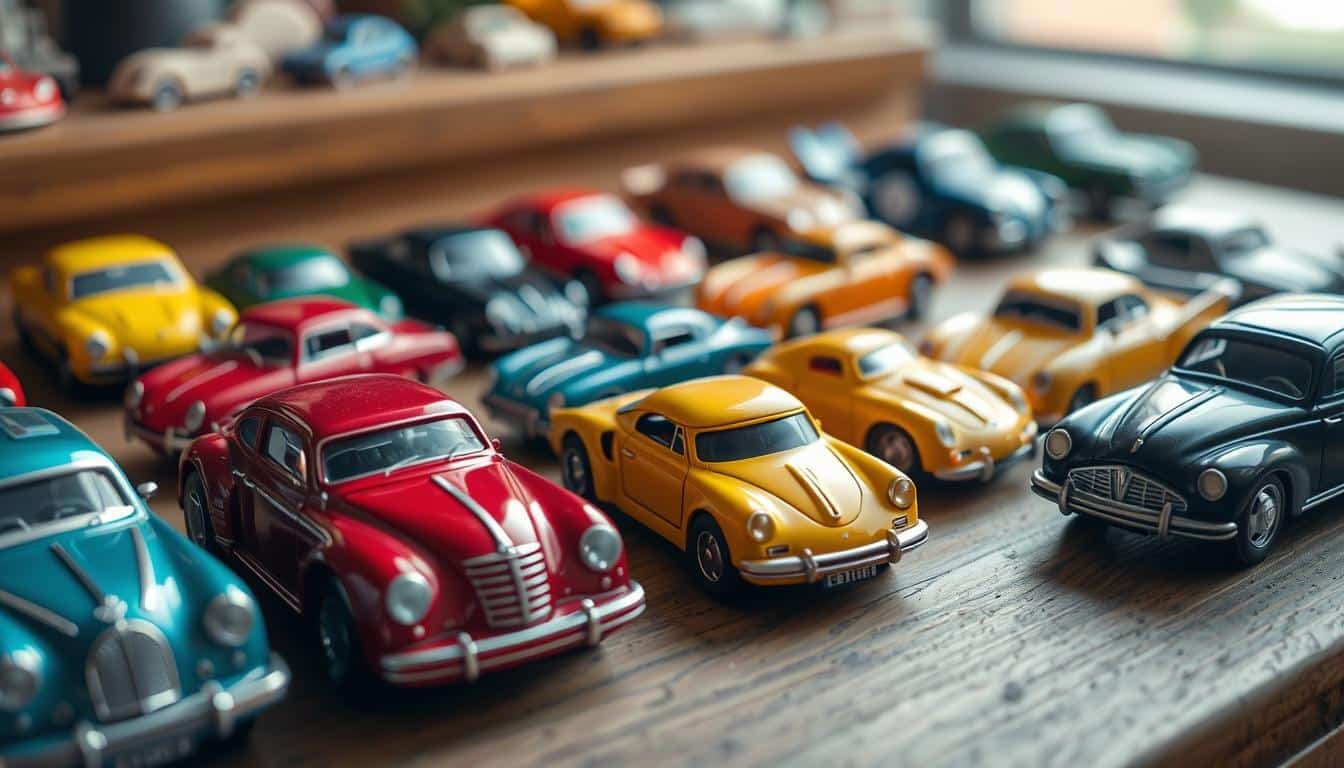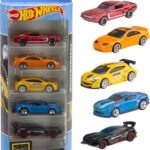Did you know that 90% of diecast toy cars have rolling wheels? This feature makes these miniatures interactive collectibles. Understanding wheel mechanics can boost your appreciation for these metal die-cast vehicles.
Diecast cars blend craftsmanship and play value. They come in various scales, each with unique appeal. The 1:64 scale is popular among beginners, allowing for large collections without high costs.
Larger 1:18 scale models boast incredible detail. They often feature diecast toy cars with working doors, hoods, and rolling wheels.
Diecast collecting offers a wide range of options. You’ll find miniature replicas of classic muscle cars and modern supercars. These collectibles connect us to automotive history in a tangible way.
Brands like Biante and Classic Carlectables are known for Australian models. Kyosho excels in Japanese marques. Many feature precise wheel mechanics mirroring full-sized cars.
Key Takeaways
- 90% of diecast cars have rolling wheels
- Scales range from 1:64 to 1:18, catering to different collector preferences
- High-quality brands include AutoArt, Biante, and Kyosho
- Wheel functionality adds to the play value and collectibility
- Diecast cars offer a mix of craftsmanship and interactive features
- Collecting can focus on specific themes, eras, or manufacturers
Understanding Diecast Car Wheel Mechanics
Diecast car wheel mechanics are vital in scale model cars. Moving parts, especially spinning wheels, add authenticity to precision-built replicas. Toy car enthusiasts value these features in their collections.
Types of Wheel Movement Systems
Diecast cars have various wheel movement systems. Free-rolling wheels are common in play-oriented models. Some collector’s items may have fixed wheels for display purposes.
The system choice impacts both playability and collector value. Each type serves a specific purpose for different enthusiasts.
Factors Affecting Wheel Mobility
Several factors influence replica wheel mobility on diecast cars:
- Manufacturing quality
- Scale of the model
- Materials used (metal or plastic)
- Axle design
These elements determine wheel turning smoothness and functionality longevity. Quality scale model cars often use metal axles and wheels.
Metal components ensure durability and smooth rotation. This choice enhances the overall quality of the model.
Common Issues with Rolling Wheels
Diecast car wheels can face problems despite careful design. Flat spots, wheel lock, and misalignment are frequent issues collectors encounter.
Regular maintenance helps prevent these problems. It keeps your precision-built replicas in top condition for years to come.
| Issue | Cause | Solution |
|---|---|---|
| Flat spots | Prolonged static display | Regular rotation |
| Wheel lock | Dirt accumulation | Cleaning and lubrication |
| Misalignment | Poor handling | Careful adjustment |
Understanding these mechanics helps toy car enthusiasts maintain their collections. Proper care ensures longevity and value of these miniature treasures.
Toy vehicles offer more than just collectible value. They can benefit child development through play. Learn more in this informative article about childhood growth through toys.
Do Diecast Cars Wheels Move: Care and Maintenance
Proper care keeps metal die-cast vehicles in top shape. Diecast car wheels do move, but need attention to stay functional. Let’s look at how to preserve your collectible models.
Preventing Wheel Lock and Flat Spots
Keep diecast car wheels moving smoothly by avoiding long periods in one position. Rotate your models often to prevent tire flat spots. This simple habit can extend your collection’s life significantly.
Display Solutions for Wheel Protection
Use proper display methods to protect your metal die-cast vehicles. Place cars on custom stands or shelves that let wheels hang free. This shows off your collection and keeps wheels mobile.
Cleaning and Lubricating Moving Parts
Clean regularly to keep wheels working well. The Woodland Scenics Roto wheel cleaner (£24.50) works great for this. For deeper cleaning, try the Gaugemaster wheel cleaning brush (£19.95).
Using Spacers and Washers for Wheel Preservation
Use spacers and washers to lift your models slightly. This lets wheels hang free, cutting down on wear. These steps ensure your diecast car wheels move freely for years.
FAQ
Do all diecast car wheels move?
What causes diecast car wheels to stop moving?
How can I prevent flat spots on my diecast car wheels?
What’s the best way to clean diecast car wheels?
Can I replace the wheels on my diecast car?
Do moving wheels affect the value of collectible diecast cars?
How do I store my diecast cars to protect the wheels?
Are there differences in wheel quality between diecast car brands?
Source Links
- No title found – https://www.carmodels.com.au/blogs/news/15910-guide-to-buying-diecast-model-cars
- How Do I Start Collecting Diecast Cars? A Beginner Guide – https://livecarmodel.com/blog/how-do-i-start-collecting-diecast-cars-a-beginner-guide/?srsltid=AfmBOoqUApTt7r6hJULddRXugbJhEknQBQTGmj9iLg2WQ3jh6F52qHbK
- What Differentiates Diecast and Resin Model Cars – Gauge Magazine – https://gaugemagazine.com/what-differentiates-diecast-and-resin-model-cars/
- Removing wheels from alxes? – Model Care – http://forums.dhsdiecast.com/default.aspx?g=posts&t=132077
- Mousetrap Car – Explained – https://www.instructables.com/Mousetrap-Car-Explained/
- Why Diecast Models Make Great Educational Tools for Children – https://diecastparkingapp.com/blog/why-diecast-model-cars-make-great-educational-tools-for-children
- How to keep wheels clean for trouble free running – https://www.keymodelworld.com/article/how-keep-wheels-clean-trouble-free-running








Are wheel movement systems in diecast cars really that crucial for collectors? Dont aesthetics and brand carry more weight?
Interesting piece, but why obsess over wheel mechanics? Isnt the overall design and brand rarity what truly defines a diecast cars worth? Just a thought.
Interesting read, but isnt the joy of collecting about aesthetics, not whether the wheels turn? Seems like misplaced focus. Thoughts?
Interesting read! But does the type of wheel movement system really affect a diecast car’s value or is it just aesthetics?